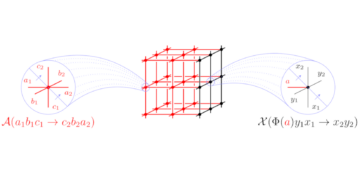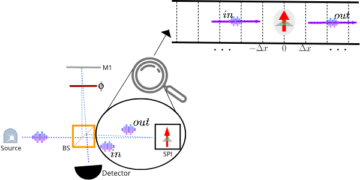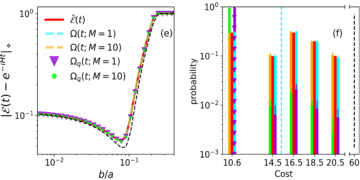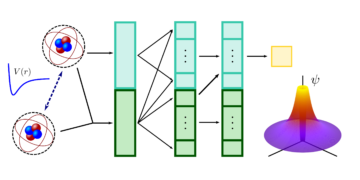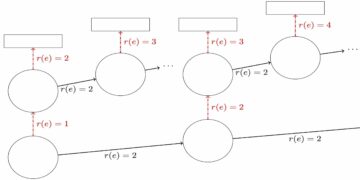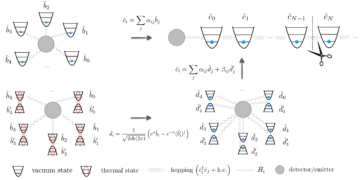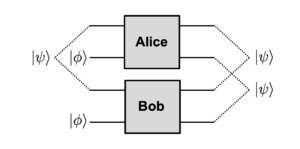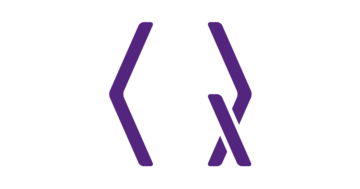1Xanadu, टोरंटो, ओन्टेरियो, M5G 2C8, कनाडा
2Hearne इंस्टीट्यूट फॉर सैद्धांतिक भौतिकी और भौतिकी और खगोल विज्ञान विभाग, लुइसियाना स्टेट यूनिवर्सिटी, बैटन रूज, LA USA
इस पेपर को दिलचस्प खोजें या चर्चा करना चाहते हैं? Scate या SciRate पर एक टिप्पणी छोड़ दें.
सार
Photon loss is destructive to the performance of quantum photonic devices and therefore suppressing the effects of photon loss is paramount to photonic quantum technologies. We present two schemes to mitigate the effects of photon loss for a Gaussian Boson Sampling device, in particular, to improve the estimation of the sampling probabilities. Instead of using error correction codes which are expensive in terms of their hardware resource overhead, our schemes require only a small amount of hardware modifications or even no modification. Our loss-suppression techniques rely either on collecting additional measurement data or on classical post-processing once the measurement data is obtained. We show that with a moderate cost of classical post processing, the effects of photon loss can be significantly suppressed for a certain amount of loss. The proposed schemes are thus a key enabler for applications of near-term photonic quantum devices.

Featured image: Mitigate the effect of photon loss for a two-mode squeezed vacuum state. Here $P([n, n])$ is the probability of detecting a photon number pattern $[n, n]$.
लोकप्रिय सारांश
► BibTeX डेटा
► संदर्भ
[1] एजी फाउलर, एम। मारियाटोनी, जेएम मार्टिनिस, और एएन क्लेलैंड, भूतल कोड: व्यावहारिक बड़े पैमाने पर क्वांटम गणना, भौतिक विज्ञान की ओर। रेव। ए 86, 032324 (2012)।
https: / / doi.org/ 10.1103 / PhysRevA.86.032324
[2] जे। प्रिसिल, क्वांटम कम्प्यूटिंग इन एनआईएसक्यू युग और उससे आगे, क्वांटम 2, 79 (2018)।
https://doi.org/10.22331/q-2018-08-06-79
[3] S. Boixo, S. V. Isakov, V. N. Smelyanskiy, R. Babbush, N. Ding, Z. Jiang, M. J. Bremner, J. M. Martinis, and H. Neven, Characterizing quantum supremacy in near-term devices, Nature Physics 14, 595 (2018).
https: / / doi.org/ 10.1038 / s41567-018-0124-x
[4] S. Aaronson, and L. Chen, Complexity-theoretic foundations of quantum supremacy experiments, arXiv:1612.05903.
arXiv: 1612.05903v1
[5] F. Arute, et al., Quantum supremacy using a programmable superconducting processor, Nature 574, 505 (2019).
https://doi.org/10.1038/s41586-019-1666-5
[6] M. J. Bremner, R. Jozsa, and D. J. Shepherd, Classical simulation of commuting quantum computations implies collapse of the polynomial hierarchy, Proceedings of the Royal Society A: Mathematical, Physical and Engineering Sciences 467, 459 (2011).
https: / / doi.org/ 10.1098 / rspa.2010.0301
[7] M. J. Bremner, A. Montanaro, and D. J. Shepherd, Average-case complexity versus approximate simulation of commuting quantum computations, Phys. Rev. Lett. 117, 080501 (2016).
https: / / doi.org/ 10.1103 / PhysRevLett.117.080501
[8] M. J. Bremner, A. Montanaro, and D. J. Shepherd, Achieving quantum supremacy with sparse and noisy commuting quantum computations, Quantum 1, 8 (2017).
https://doi.org/10.22331/q-2017-04-25-8
[9] S. Aaronson, A. Arkhipov, The computational complexity of linear optics, Proceedings of the forty-third annual ACM symposium on Theory of computing, 333-342 (2011).
https: / / doi.org/ 10.1145 / १.१३,९४,२०८
[10] C. S. Hamilton, R. Kruse, L. Sansoni, S. Barkhofen, C. Silberhorn, Christine, and I. Jex, Gaussian Boson Sampling, Phys. Rev. Lett. 119, 170501 (2017).
https: / / doi.org/ 10.1103 / PhysRevLett.119.170501
[11] S. Rahimi-Keshari, A. P. Lund, and T. C. Ralph, What Can Quantum Optics Say about Computational Complexity Theory?, Phys. Rev. Lett. 114, 060501 (2015).
https: / / doi.org/ 10.1103 / PhysRevLett.114.060501
[12] S. Rahimi-Keshari, T. C. Ralph, and C. M. Caves, Sufficient Conditions for Efficient Classical Simulation of Quantum Optics, Phys. Rev. X 6, 021039 (2016).
https: / / doi.org/ 10.1103 / PhysRevX.6.021039
[13] A. Peruzzo, J. McClean, P. Shadbolt, M. Yung, X. Zhou, P. J. Love, A. Aspuru-Guzik, and J. L. O’brien, A variational eigenvalue solver on a photonic quantum processor, Nature Communications 5, 4213 (2014).
https: / / doi.org/ 10.1038 / ncomms5213
[14] E. Farhi, J. Goldstone, and S. Gutmann, A quantum approximate optimization algorithm, arXiv:1411.4028.
arXiv: 1411.4028
[15] E. Farhi, and A. W. Harrow, Quantum supremacy through the quantum approximate optimization algorithm, arXiv:1602.07674.
arXiv: 1602.07674
[16] के। टेम, एस। ब्रवी, और जेएम गैम्बेटा, लघु-गहराई क्वांटम सर्किट के लिए त्रुटि शमन, भौतिकी। रेव। लेट। 119, 180509 (2017)।
https: / / doi.org/ 10.1103 / PhysRevLett.119.180509
[17] Y. Li, and S. C. Benjamin, Efficient Variational Quantum Simulator Incorporating Active Error Minimization, Phys. Rev. X 7, 021050 (2017).
https: / / doi.org/ 10.1103 / PhysRevX.7.021050
[18] A. Kandala, K. Temme, A. D. Córcoles, A. Mezzacapo, J. M. Chow, and J. M. Gambetta, Error mitigation extends the computational reach of a noisy quantum processor, Nature 567, 491 (2019).
https://doi.org/10.1038/s41586-019-1040-7
[19] एस। एंडो, एससी बेंजामिन और वाई। ली, प्रैक्टिकल क्वांटम एरर मिटिगेशन फ़ॉर नियर-फ़्यूचर एप्लीकेशन, फ़िज़। रेव। X 8, 031027 (2018)।
https: / / doi.org/ 10.1103 / PhysRevX.8.031027
[20] C. Song, J. Cui, H. Wang, J. Hao, H. Feng, H. and Li, Ying, Quantum computation with universal error mitigation on a superconducting quantum processor, Science Advances 5, (2019).
https: / / doi.org/ 10.1126 / sciadv.aaw5686
[21] S. Zhang, Y. Lu, K. Zhang, W. Chen, Y. Li, J. Zhang, and K. Kim, Error-mitigated quantum gates exceeding physical fidelities in a trapped-ion system, Nature Communications 11, 1 (2020).
https: / / doi.org/ 10.1038 / s41467-020-14376-z
[22] एक्स। बोनट-मोनरोइग, आर। सगास्ताज़ाबाल, एम। सिंह, और टीई ओ ब्रायन, समरूपता सत्यापन, भौतिकी द्वारा कम लागत वाली त्रुटि शमन। रेव। ए 98, 062339 (2018)।
https: / / doi.org/ 10.1103 / PhysRevA.98.062339
[23] R. Sagastizabal, X. Bonet-Monroig, M. Singh, M. A. Rol, C. C. Bultink, X. Fu, C. H. Price, V. P. Ostroukh, N. Muthusubramanian, A. Bruno, M. Beekman, N. Haider, T. E. O’Brien, and L. DiCarlo, Experimental error mitigation via symmetry verification in a variational quantum eigensolver, Phys. Rev. A 100, 010302(R) (2019).
https: / / doi.org/ 10.1103 / PhysRevA.100.010302
[24] S. McArdle, X. Yuan, and S. Benjamin, Error-Mitigated Digital Quantum Simulation, Phys. Rev. Lett. 122, 180501 (2019).
https: / / doi.org/ 10.1103 / PhysRevLett.122.180501
[25] एक्स। बोनट-मोनरोइग, आर। सगास्ताज़ाबाल, एम। सिंह, और टीई ओ ब्रायन, समरूपता सत्यापन, भौतिकी द्वारा कम लागत वाली त्रुटि शमन। रेव। ए 98, 062339 (2018)।
https: / / doi.org/ 10.1103 / PhysRevA.98.062339
[26] M. Cerezo, K. Sharma, A. Arrasmith, and P. J. Coles, Variational quantum state eigensolver, arXiv:2004.01372.
arXiv: 2004.01372
[27] जेआर मैकक्लेन, जे। रोमेरो, आर। बब्बूश, और ए। असपुरु-गुज़िक, द थ्योरी ऑफ़ वैरिएबल हाइब्रिड क्वांटम-क्लासिकल एल्गोरिदम, न्यू जर्नल ऑफ़ फिज़िक्स 18, 023023 (2016)।
https://doi.org/10.1088/1367-2630/18/2/023023
[28] के. शर्मा, एस. खत्री, एम. सेरेज़ो, और पी.जे. कोल्स, नॉइज़ रेजिलिएशन ऑफ़ वेरिएबल क्वांटम कंपाइलिंग, न्यू जर्नल ऑफ़ फ़िज़िक्स 22, 043006 (2020)।
https: / / doi.org/ 10.1088 / 1367-2630 / ab784c
[29] L. Cincio, K. Rudinger, M. Sarovar, and P. J. Coles, Machine learning of noise-resilient quantum circuits, PRX Quantum 2, 010324 (2021).
https: / / doi.org/ 10.1103 / PRXQuantum.2.010324
[30] Y. Chen, M. Farahzad, S. Yoo, and T. Wei, Detector tomography on IBM quantum computers and mitigation of an imperfect measurement, Phys. Rev. A 100, 052315 (2019).
https: / / doi.org/ 10.1103 / PhysRevA.100.052315
[31] M. R. Geller, and M. Sun, Efficient correction of multiqubit measurement errors, arXiv:2001.09980.
arXiv: 2001.09980
[32] L. Funcke, T. Hartung, K. Jansen, S. Kühn, P. Stornati, and X. Wang, Measurement error mitigation in quantum computers through classical bit-flip correction, arXiv:2007.03663.
arXiv: 2007.03663
[33] H. Kwon, and J. Bae, A hybrid quantum-classical approach to mitigating measurement errors in quantum algorithms, IEEE Transactions on Computers (2020).
https: / / doi.org/ 10.1109 / TC.2020.3009664
[34] J. R. McClean, M. E. Kimchi-Schwartz, J. Carter, and W. A. de Jong, Hybrid quantum-classical hierarchy for mitigation of decoherence and determination of excited states, Phys. Rev. A 95, 042308 (2017).
https: / / doi.org/ 10.1103 / PhysRevA.95.042308
[35] J. Sun, X. Yuan, T. Tsunoda, V. Vedral, S. C. Bejamin, and S. Endo, Mitigating Realistic Noise in Practical Noisy Intermediate-Scale Quantum Devices, Phys. Rev. Applied 15, 034026 (2021).
https: / / doi.org/ 10.1103 / PhysRevApplied.15.034026
[36] A. Strikis, D. Qin, Y. Chen, B. C. Benjamin, and Y. Li, Learning-based quantum error mitigation, arXiv:2005.07601.
arXiv: 2005.07601
[37] P. Czarnik, A. Arrasmith, P. J. Coles, and L. Cincio, Error mitigation with Clifford quantum-circuit data, arXiv:2005.10189.
arXiv: 2005.10189
[38] A. Zlokapa, and A. Gheorghiu, A deep learning model for noise prediction on near-term quantum devices, arXiv:2005.10811.
arXiv: 2005.10811
[39] J. Arrazola, and T. R. Bromley, Using Gaussian Boson Sampling to Find Dense Subgraphs, Phys. Rev. Lett. 121, 030503 (2018).
https: / / doi.org/ 10.1103 / PhysRevLett.121.030503
[40] K. Brádler, S. Friedland, J. Izaac, N. Killoran, and D. Su, Graph isomorphism and Gaussian boson sampling, Spec. Matrices 9, 166 (2021).
https://doi.org/10.1515/spma-2020-0132
[41] M. Schuld, K. Brádler, R. Israel, D. Su, and B. Gupt, Measuring the similarity of graphs with a Gaussian boson sampler, Phys. Rev. A 101, 032314 (2020).
https: / / doi.org/ 10.1103 / PhysRevA.101.032314
[42] K. Brádler, R. Israel, M. Schuld, and D. Su, A duality at the heart of Gaussian boson sampling, arXiv:1910.04022.
arXiv: 1910.04022v1
[43] सी। वेदब्रुक, एस। पिरंडोला, आर। गार्सिया-पैट्रोन, एनजे सेर्फ़, टीसी राल्फ, जेएच शापिरो और एस। लॉयड, गॉसियन क्वांटम जानकारी, रेव। मॉड। भौतिकी। 84, 621 (2012)।
https: / / doi.org/ 10.1103 / RevModPhys.84.621
[44] K. Brádler, P. Dallaire-Demers, P. Rebentrost, D. Su, and C. Weedbrook, Gaussian boson sampling for perfect matchings of arbitrary graphs, Phys. Rev. A 98, 032310 (2018).
https: / / doi.org/ 10.1103 / PhysRevA.98.032310
[45] H. Qi, D. J. Brod, N. Quesada, and R. García-Patrón, Regimes of Classical Simulability for Noisy Gaussian Boson Sampling, Phys. Rev. Lett. 124, 100502 (2020).
https: / / doi.org/ 10.1103 / PhysRevLett.124.100502
[46] W. R. Clements, P. C. Humphreys, B. J. Metcalf, W. S. Kolthammer, and I. A. Walsmley, Optimal design for universal multiport interferometers, Optica 3, 1460 (2016).
https: / / doi.org/ 10.1364 / OPTICA.3.001460
[47] M. Reck, A. Zeilinger, H. J. Bernstein, and P. Bertani, Experimental Realization of Any Discrete Unitary Operator, Phys. Rev. Lett. 73, 58 (1994).
https: / / doi.org/ 10.1103 / PhysRevLett.73.58
[48] M. Jacques, A. Samani, E. El-Fiky, D. Patel, X. Zhenping, and D. V. Plant, Optimization of thermo-optic phase-shifter design and mitigation of thermal crosstalk on the SOI platform, Opt. Express 27, 10456 (2019).
https: / / doi.org/ 10.1364 / OE.27.010456
[49] A. Serafini, Quantum Continuous Variables: A Primer of Theoretical Methods (CRC Press, 2017).
[50] J. Huh, G. G. Guerreschi, B. Peropadre, J. R. McClean, and A. Aspuru-Guzik, Boson sampling for molecular vibronic spectra, Nature Photonics 9, 615 (2015).
https: / / doi.org/ 10.1038 / nphoton.2015.153
[51] S. Rahimi-Keshari, M. A. Broome, R. Fickler, A. Fedrizzi, T. C. Ralph, and A. G. White, Direct characterization of linear-optical networks, Opt. Express 21, 13450 (2013).
https: / / doi.org/ 10.1364 / OE.21.013450
[52] V. Giovannetti, A. S. Holevo, and R. García-Patrón, A Solution of Gaussian Optimizer Conjecture for Quantum Channels, Commun. Math. Phys. 334, 1553 (2015).
https://doi.org/10.1007/s00220-014-2150-6
[53] R. García-Patrón, J. Renema, and V. Shchesnovich, Simulating boson sampling in lossy architectures, Quantum 3, 169 (2019).
https://doi.org/10.22331/q-2019-08-05-169
[54] R. Kruse, C. S. Hamilton, L. Sansoni, S. Barkhofen, C. Silberhorn, and I. Jex, Detailed study of Gaussian boson sampling, Phys. Rev. A 100, 032326 (2019).
https: / / doi.org/ 10.1103 / PhysRevA.100.032326
द्वारा उद्धृत
[११] एम। सेरेज़ो, एंड्रयू अर्र्समिथ, रयान बाबुश, साइमन सी। बेंजामिन, सगुरू एंडो, कीसुके फ़ूजी, जारोद आर। मैकक्लेन, कोसुके मितराई, जिओ युआन, लतास सिनसियो, और पैट्रिक जे। कोल्स, "वैरिएंट क्वांटम एल्गोरिथम"। arXiv: 2012.09265.
[२] टायलर वोल्कॉफ, ज़ो होम्स, और एंड्रयू सोर्नबोर्गर, "यूनिवर्सल कंपाइलिंग एंड (नो-) फ्री-लंच थ्योरम्स फॉर कंटीन्यूअस वेरिएबल क्वांटम लर्निंग", arXiv: 2105.01049.
[3] Shreya P. Kumar, Leonhard Neuhaus, Lukas G. Helt, Haoyu Qi, Blair Morrison, Dylan H. Mahler, and Ish Dhand, “Mitigating linear optics imperfections via port allocation and compilation”, arXiv: 2103.03183.
[२] साद यलूज़, ब्रूनो सेनजेन, फिलिप्पो मिआटो, और वेदरन डोंजको, "एक फोटोनिक क्वांटम कंप्यूटर पर कई-बोसोन तरंगों को जोरदार रूप से सहसंबद्ध करते हुए, आकर्षक बोस-हबर्ड मॉडल के लिए": arXiv: 2103.15021.
उपरोक्त उद्धरण से हैं SAO / NASA ADS (अंतिम अद्यतन सफलतापूर्वक 2021-05-07 23:43:35)। सूची अधूरी हो सकती है क्योंकि सभी प्रकाशक उपयुक्त और पूर्ण उद्धरण डेटा प्रदान नहीं करते हैं।
On Crossref की उद्धृत सेवा द्वारा कार्यों का हवाला देते हुए कोई डेटा नहीं मिला (अंतिम प्रयास 2021-05-07 23:43:33)।
यह पत्र क्वांटम में प्रकाशित हुआ है क्रिएटिव कॉमन्स एट्रिब्यूशन 4.0 इंटरनेशनल (CC बाय 4.0) लाइसेंस। कॉपीराइट मूल कॉपीराइट धारकों जैसे लेखकों या उनकी संस्थाओं के पास रहता है।
- "
- 100
- 11
- 2016
- 2019
- 2020
- 2021
- 39
- 7
- 84
- 9
- 98
- पहुँच
- सक्रिय
- अतिरिक्त
- लाभ
- कलन विधि
- एल्गोरिदम
- सब
- आवंटन
- आवेदन
- अनुप्रयोगों
- खगोल
- लेखकों
- चैनलों
- एकत्रित
- संचार
- आने
- कंप्यूटर्स
- कंप्यूटिंग
- Copyright
- तिथि
- ध्यान लगा के पढ़ना या सीखना
- यह
- डिज़ाइन
- डिवाइस
- डिजिटल
- अभियांत्रिकी
- पाता
- भविष्य
- गेट्स
- हार्डवेयर
- हावर्ड
- यहाँ उत्पन्न करें
- HTTPS
- संकर
- आईबीएम
- आईईईई
- की छवि
- करें-
- संस्थानों
- अंतरराष्ट्रीय स्तर पर
- इजराइल
- IT
- जावास्क्रिप्ट
- कुंजी
- बड़ा
- सीख रहा हूँ
- लाइसेंस
- सूची
- लुइसियाना
- मोहब्बत
- यंत्र अधिगम
- गणित
- आदर्श
- निकट
- नेटवर्क
- शोर
- ओंटारियो
- खुला
- प्रकाशिकी
- काग़ज़
- पैटर्न
- वेतन
- प्रदर्शन
- भौतिक विज्ञान
- मंच
- व्यावहारिक अनुप्रयोगों
- भविष्यवाणी
- वर्तमान
- दबाना
- मूल्य
- भजन की पुस्तक
- प्रकाशकों
- मात्रा
- क्वांटम कंप्यूटर
- क्वांटम कम्प्यूटिंग
- संसाधन
- उपयुक्त संसाधन चुनें
- रॉबर्ट
- विज्ञान
- विज्ञान
- अनुकार
- सिम्युलेटर
- छोटा
- समाज
- राज्य
- राज्य
- अध्ययन
- सतह
- प्रणाली
- टेक्नोलॉजीज
- थर्मल
- टोरंटो
- लेनदेन
- सार्वभौम
- विश्वविद्यालय
- वैक्यूम
- सत्यापन
- बनाम
- आयतन
- W
- काम
- कार्य
- X
- वर्ष
- युआन

